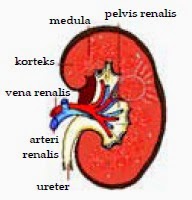Abnormality or disease in Excretion System - Abnormalities or diseases that occur in the excretory system assortment, among others, are as follows.
1. Albuminuria
Albuminuria is because there are abnormalities in the kidneys albumin and protein in the urine. This is a symptom of damage to the kidney filtration apparatus. the disease is cause too much albumin escape from the filter kidney and wasted with urine. albumin is proteins that are beneficial to humans because it serves to prevent the liquid is not too much out of blood. Causes of albuminuria which are deficient protein, kidney disease, and liver disease.
2. Diabetes Mellitus
Diabetes mellitus is a disorder of the kidneys due to the presence of sugar (glucose) in the urine caused by insulin deficiency. This is because overhaul process disrupted glucose into glycogenso that the blood glucose rise. The kidneys are not able to absorb all the glucose. As a result, glucose excreted with urine.
Diabetes mellitus should be managed and controlled well so that the sufferer can feel comfortable and healthy, and can prevent complications. Efforts to control diabetes mellitus in whom are:
- Check with your doctor to schedule/routine.
- Take medications as directed by your doctor.
- Set the diet.
- Exercise regularly.
- Conduct periodic laboratory examinations.
3. Diabetes insipidus
Diabetes insipidus is a disorder in the system because of lack of antidiuretic hormone excretion. abnormality this can cause excessive thirst and of urine into many and very dilute. Diabetes insipidus is caused by a decrease in the formation of antidiuretic hormone, the hormone that is naturally prevents the formation of urine that is too much. Diabetes insipidus can also occur if the levels antidiuretic hormone to normal, but the kidneys do not provide normal response to this hormone (a condition called nephrogenic diabetes insipidus).
Other causes of diabetes insipidus are:
- Damage to the hypothalamus or pituitary gland as a result of surgery.
- Brain injuries (mainly fractures at the base of the skull).
- Tumors.
- Sarcoidosis or tuberculosis.
- Aneurysm or blockage of arteries leading to the brain.
- Some forms of encephalitis or meningitis.
- Histiositosis X (disease Hand-Schuller-Christian).
Diabetes insipidus can be treated by addressing cause. Vasopressin or desmopressin acetate (modified from antidiuretic hormone) can be given as a nasal spray several times a day expenditures to maintain urine normal. But it must be careful, because if too many taking this drug can lead to hoarding fluid, swelling, and other disorders. Injection antidiuretic hormone is given to patients who would patients undergoing surgery or unconscious themselves.
Diabetes insipidus can also be controlled by medicines which stimulates the production of antidiuretic hormone, such as chlorpropamide, carbamazepine, klofibrat, and various diuretics (thiazides). However, these medications may not totally relieve symptoms in diabetes insipidus heavy.
4. Nephritis
Nephritis is a disease of the kidneys due to damage the glomerulus caused by bacterial infection.This disease can lead to uremia (urea and acid urine re-enter the blood) so the ability impaired water absorption. The result is the accumulation of water on foot or often called edema (foot sufferers swell).
This phenomenon appears to occur more frequently in early childhood and adults than in the half aged. Patients usually complain of feeling cold, fever, headache, back pain, and edema (swelling) usually on the face around the eyes (lids), nausea, and vomiting. Difficult urination and urine became turbid.
5. Kidney Stones
Kidney stones is a disease that occurs due to stones in the kidney. The stone is a compound calcium and uric acid buildup. Stone formation could occur due to urine saturated with salts can form stones or urine because shortages normal inhibitors of stone formation. About 80% kidney stones composed of calcium. Stone size varies, start of which can not be seen with the naked eye to that of 2.5 cm or more. This stone can fill almost the entire renal pelvis and renal calices. Small stones that do not cause symptoms of obstruction or infection, usually do not need to be treated. drink lots fluids will increase urine formation and help throw some rocks. If the stone has been wasted, do not need immediate treatment.
Stone in the renal pelvis or ureter most top measuring 1 cm or less often solved by ultrasonic waves (extracorporeal shock wave lithotripsy, ESWL). Rock fragments will then be discarded in the urine. Sometimes a stone is removed through an incision small skin followed by ultrasonic treatment. Small stones in the lower ureter can be removed the endoscope is inserted through the urethra and into the bladder.
Uric acid stones, sometimes will dissolve gradually the urine alkaline atmosphere (eg by provide potassium citrate). However, other stone can not be addressed in this way. Uric acid stones larger can cause a blockage that needs to be removed surgically.
6. Polyuria and oliguria
Polyuria is a disorder of the kidneys, where urine issued very much and dilute. Meanwhile, oliguria is produced very little urine.
7. Anuria
Anuria is kidney failure that can not be make urine. It is caused by a defect the glomerulus. As a result, the filtration process can not be done and no urine is produced. As a result of the anuria, then there will be balance disorders in the body. For example, buildup of fluid, electrolyte, and the remnants of metabolism body that should come out with urine. This condition which will provide the clinical picture than anuria.
Anuria precautions are essential to performed. For example, in a state that allows the occurrence of high anuria, fluid administration for the body should always sought before anuria occurred.
8. Acne
Acne is a skin condition which occurs blockage of the oil glands of the skin accompanied by infection and inflammation. It usually occurs in adolescence due increased hormones. Acne can occur on the face, chest, or backs. Many ways to deal with acne and a variety of drugs offered to address this one skin disorder.
To treat acne, you need adequate sleep, minimum 7 hours a day, multiply to consume fruits and vegetables. besides that, if you can reduce or avoid eating food starchy, sugary, chocolate, and nuts.
9. Eczema
Eczema is a skin disorder because the skin becomes dry, reddish, itchy, and scaly. Generally, the symptoms of eczema are visible swelling and itching of the skin. The cause of eczema include:
- Allergy to soaps, creams lotions, ointments, or metal particular.
- Fatigue.
- Stress.
In general, eczema is not dangerous, in meaning no cause of death and is not contagious. However, eczema can cause discomfort and Particularly disturbing. Therefore, it is necessary to treat eczema the following ways:
- Do not keep changing soap. Use soap bath soft, not too frothy, and not eliminate the body's natural oils.
- Use clean water for bathing.
- Rub body with a soft towel and clean immediately after bathing to truly skin surface dry.
- Diligent hand washing with soap and then rinse and pat dry.
10. Gangrene
Gangrene is a skin disorder due to death tissue cells of the body. This is caused by the blood supply poor to a particular body part. Blood supply bad can be caused by pressure on the vessel blood (eg, bandage that is too tight). Sometimes, gangrene caused by direct injury (gangrene traumatic) or infection.






